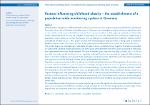Factors influencing childhood obesity – the establishment of a population-wide monitoring system in Germany
Varnaccia, Gianni
Zeiher, Johannes
Lange, Cornelia
Jordan, Susanne
Obesity poses a danger to childhood health and can continue to have a negative impact on health into adulthood. Currently, about 15% of children and adolescents in Germany are overweight or obese. Moreover, significant data on the multifactorial causes of childhood obesity that is systematically recorded, regularly updated and obtainable at the nationwide level are not yet available in Germany. As such, the Robert Koch Institute is establishing a population-wide system to monitor the factors that are relevant to childhood obesity (AdiMon). AdiMon will be available by the end of 2017. This paper outlines the methodological approach that is being used to establish AdiMon and describes the current results of the project (the development of an initial set of core indicators). The project began by undertaking a systematic literature review aimed at piecing together the latest knowledge on factors that influence childhood obesity. The factors that were identified were then sorted according to relevance, and appropriate indicators were selected. This was followed up by research into data sources that – as far as possible – provide significant data that are regularly collected but that also provide for regional differentiation. Work is currently underway to analyse these indicators and data sources. Once this work has been completed, the indicator set will be finalised and the results published on the internet. Population-wide monitoring of factors relevant to childhood obesity takes the following types of indicators into account: behavioural factors (such as physical activity), biological factors (such as genetic predisposition), prenatal and early-childhood factors (such as breastfeeding), psychosocial factors (such as parents’ health consciousness), environmental factors (such as playgrounds in the local area), contextual factors (such as a migrant background) and prevention measures as well as measures to promote health (such as expenditure by statutory health insurers). The population-wide monitoring uses the following data sources: epidemiological studies, social sciences surveys, official statistics and geo-information systems, as well as routine, economic and media data. This paper demonstrates that population-wide monitoring can provide significant information about the distribution and causes of obesity in childhood, and thus enable the need for action to be recognised at an early stage, initial approaches for preventive measures to be identified and developments to be tracked over time.
Dateien zu dieser Publikation
Keine Lizenzangabe

